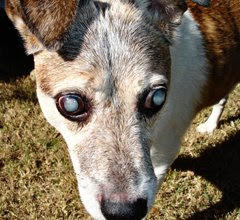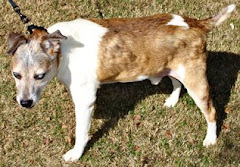Everything seems to be a bit fuzzy now, but I believe it was five or six years ago that Hunter was first diagnosed with hypothyroidism. Hunter’s weight would fluctuate between being 6, 8 to 10 pounds overweight. Hunter’s eating habits could be characterized as a “grazer.” He never sat and ate his food in one feeding. I tried to feed him that way and he wouldn’t eat. I had discussed this with his vet and he said that Hunter was a natural grazer. So, I filled his bowl and he ate throughout the day. He always had food left over in his bowl.
Other than his food, Hunter did get a few treats and chews. However, I don’t think any of them were enough to have caused him to be overweight. Then around age seven, his activity slowed down. It was attributed to him now being a “senior.”
Unfortunately, this is one of those cases of “if I knew then, what I know now,” I would have had Hunter tested for Cushing’s Disease then and every subsequent year. Like most, I had never heard of Cushing’s. I have learned, since Hunter’s death, pouring over the internet that Cushing’s can lead to hypothyroidism, along with the fact that Hunter had extremely dry skin. I mentioned before about what happened to Hunter’s coat when we found one flea. Apparently, the damage that was done to his fur was most likely due to the fact of him having Cushing’s. Their immune system is compromised and so one flea bite could cause all that damage and the painful sores because his system wouldn’t be able to fight it off.
Cushing’s was probably not thought of because he didn’t have the “classic symptoms” of ravenous eating or obsessive drinking of water. In fact, Hunter never had these two symptoms until he was diagnosed with diabetes in July 2008. Apparently, a lot of vets put off these symptoms as just normal signs of aging. Why vets don’t recommend testing for Cushing’s is beyond me. If it’s because of cost, let the owner’s make that decision. If you were like me, when Hunter was a “senior,” I opted for the complete blood panel for geriatric dogs. Two hundred dollars more would not have made a big difference to me.
Here is a list of the symptoms of Cushing’s Hunter had, which should have been red flags:
Predisposed to hypothyroidism
Routine blood work reflected elevated liver enzymes
High cholesterol
Pot-bellied appearance
Exercise intolerance, lethargy
Thinning hair on torso
Dull, dry coat
Skin problems
Panting – laying on cool surfaces
Slow or no re-growth of hair after clipping
Pigmented skin, especially on belly *
*For Jack Russell's, may notice belly is pink to red and feels warm/hot to touch.
Symptoms five months prior to being put to sleep:
Diabetes
Obsessive water consumption
Increased appetite
Easy bruising
As you can see, Hunter had a number of symptoms years before he was diagnosed with diabetes.
Hunter was diagnosed with hypothyroidism about six years ago. After being put on medication, he still looked overweight, with a pot-belly. His liver enzymes were a little off, but were never so much to be of any concern to the vet. I was unaware that Hunter’s cholesterol levels were high until a month before he died. I was talking to our vet and he mentioned that his cholesterol levels were in the 400’s and then said offhandedly, “he has always had high cholesterol levels.” Well, that was news to me!
His lethargy was written off by the vets by his being overweight, even though he barely ate. In fact, I went over how much he ate with one of the vets. He was barely eating two cups of food a day. His concern was that Hunter wasn’t getting any essential minerals and vitamins. That’s when I was adding canned food to his diet and looking for higher quality food. That’s also the time when all the dog food was recalled and I had switched him to Purina natural blends with chicken and oatmeal. Finally, I found a food where he ate most of it, instead of pushing it around with his nose or picking out pieces.
His water consumption didn’t increase much, perhaps less than 1 cup in 2006. I have now learned that in the early stages of Cushing’s the water consumption will not be much, but will increase in time. In fact, in July 2008 when he was diagnosed with diabetes, his water consumption was unreal. I would literally have to pull him away from the water. He would drink the water so fast, I thought he would drown. Even though Cushing’s was mentioned in 2006, I believe it was disregarded because he didn’t have the ravenous appetite.
His extremely dry skin was also written off as his allergies. When the cancer was removed from his inner thigh, the area where the hair was shaved never grew back. I mentioned this to the vet, there was no concern.
He started panting in 2007 and when he did pant, his belly would be pink to red in color. I also brought this up to the vet and was told he was a “hot” dog and all this was probably due to his being a few pounds overweight.
After Hunter was put to sleep, I came across a site where a woman had a picture of her German Shepherd. One picture in particular caught my attention. She had taken a picture of her dog’s belly. I could have sworn I was looking at Hunter. There was the thinning hair and pigmented skin on the belly. Luckily, her dog was a lot younger than Hunter and was reacting positively towards being on Lysodren.
I feel the internist failed Hunter and should have taken his symptom of drinking less water more seriously, as I have learned (from an animal hospital’s website) the first sign of toxicity is decreased water intake. I also feel our private vet(s) also failed Hunter for years.
The pain and guilt (did I do enough?) has been overwhelming. My daughters have been the ones to remind me that the internist was the “expert” on Lysodren, not me.
I don’t know even if the internist had acted correctly and had instructed me to take Hunter off of Lysodren on the 22nd and bring him in immediately, if that would have saved his life or not. That is something we’ll never know, but deep inside of me, I know Hunter was dying because of the Lysodren.
The thing about Cushing’s is that many pet owners aren’t even aware of what Cushing’s is and that more pets are diagnosed with Cushing’s than in the past. Unfortunately, like us, many pet owners are only able to piece together the symptoms of Cushing’s and realize (too late) that their pet had had it for a few years before they were diagnosed.
I went with the recommendation of Lysodren, because the internist said he had had better results with it than with Trilostane (Vetoryl). Trilostane was approved in January of this year by the FDA for the treatment of Cushing’s in dogs. Trilostane reduces the amount of cortisol the adrenal glands produce, without completely stopping the cortisol production; unlike Lysodren which can go too far and cause the adrenal gland from producing cortisol altogether.
I wish I had had all this knowledge prior to having Hunter treated. I would have pushed for Trilostane or Anipryl. These drugs may have taken longer to take effect, as they're not a chemotherapeutic drug. Lysodren would have definitely been a last resort. Unfortunately, I didn’t do that and I live with that regret.
I started this blog for Hunter because I wanted to bring all the information I had gathered together about his journey with Cushing’s and diabetes. Although, I never expected it to be such a short journey, the aim is still the same….to help others.



